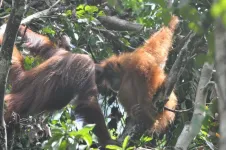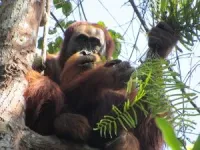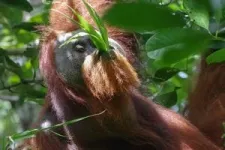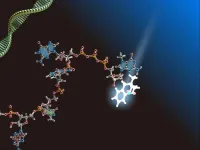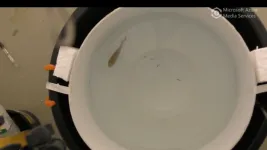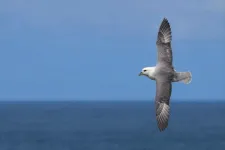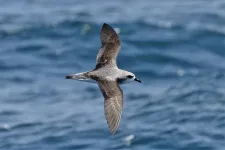(Press-News.org) Orangutans are dependent on their mothers longer than any other non-human animal, nursing until they are at least six years old and living with her for up to three years more, learning how to find, choose, and process the exceedingly varied range of foods they eat. But how do orangutans that have left their mothers and now live far from their natal ranges, where the available foods may be very different, decide what to eat and figure out how to eat it? Now, an international team of authors has shown that in such cases, migrants follow the rule ‘observe, and do as the locals do’. The results are published in Frontiers in Ecology and Evolution.
“Here we show evidence that migrant orangutan males use observational social learning to learn new ecological knowledge from local individuals after dispersing to a new area,” said Julia Mörchen, a doctoral student at the Max Planck Institute for Evolutionary Anthropology and the University of Leipzig, in Germany, and the study’s lead author. “Our results suggest that migrant males not only learn where to find food and what to feed on from locals, but also continue to learn how to process these new foods.”
Mörchen and colleagues showed that migrant males learn this information through a behavior called ‘peering’: intensely observing for at least five seconds and from within two meters at a role model. Typically, peering orangutans faced the role model and showed signs of following his or her actions with head movements, indicating attentive interest.
Male orangutans migrate to another area after becoming independent, while females tend to settle close to their natal home range.
“What we don’t yet know is how far orangutan males disperse, or where they disperse to. But it’s possible to make informed guesses: genetic data and observations of orangutans crossing physical barriers such as rivers and mountains suggest long-distance dispersal, likely over tens of kilometers,” said Mörchen.
“This implies that during migration, males likely come across several habitat types and thus experience a variety of faunistic compositions, especially when crossing through habitats of different altitudes. Over evolutionary time, being able to quickly adapt to novel environments by attending to crucial information from locals, likely provided individuals with a survival advantage. As a result, this ability is likely ancestral in our hominin lineage, reaching back at least between 12 and 14 million years to the last common ancestor we share with orangutans.”
The authors analyzed 30 years of observations, collected by 157 trained observers, on 77 migrant adult males of the highly sociable Sumatran orangutan Pongo abelii at the Suaq Balimbing research station in Southwest Aceh, and 75 adult migrant males of the less sociable Bornean orangutan Pongo pygmaeus wurmbii at the Tuanan station in Central Kalimantan. They focused on every observation of peering behavior during 4,009 occasionswhen these males were within 50 meters of one or more neighbors, who could be adult females, juveniles, or adult males.
Peering by males was observed 534 times, occurring in 207 (5.2%) of these associations. In Suaq Balimbing, males most frequently peered at local females followed by at local juveniles, and least at adult males. In the less sociable population of Tuanan, the opposite held: males most frequently peered at adult males followed by immature orangutans, and least at adult females. Migrant males at Tuanan may lack opportunities to peer at local females, as females are known to avoid long associations with them in this population.
Migrant males then interacted more frequently with the peered-at food afterwards, putting into practice what they learned through peering.
“Our detailed analyses further showed that the migrant orangutan males in our study peered most frequently at food items that are difficult to process, or which are only rarely eaten by the locals: including foods that were only ever recorded to be eaten for a couple of minutes, throughout the whole study time,” said Dr Anja Widdig, a professor at the University of Leipzig and co-senior author of the study.
“Interestingly, the peering rates of migrant males decreased after a couple of months in the new area, which implies that this is how long it takes them to learn about new foods,” added Dr Caroline Schuppli, a group leader at the Max Planck Institute of Animal Behavior in Konstanz, and co-senior author.
The authors cautioned that it’s still unknown how many times adult orangutans need to peer at a particular behavior to learn to master it. Observations suggest that depending on the complexity or novelty of the learned skill, adults may still use explorative behaviors on certain food items they first learned about through peering – possibly to figure out more details, strengthen and memorize the new information, or to compare the latter with previous knowledge.
END
Migrant orangutans learn which foods are good to eat by watching the locals
Migrants male orangutans ‘peer’ at role models to learn about new foods, especially those hard to process or rarely eaten
2023-07-05
ELSE PRESS RELEASES FROM THIS DATE:
Pure capped mRNA vaccine opens the door to more effective vaccines with lower chances of inflammation
2023-07-05
A research group from Japan has developed a method to produce highly active mRNA vaccines at high purity using a unique cap to easily separate the desired capped mRNA. This ‘Purecap’ technique extracted up to 100% pure Cap2-type mRNA, which showed 3-4 times better production of the protein that stimulates the immune system. These results open up the possibility of purer vaccines with a lower risk of inflammation caused by impurities. Their findings were published in Nature Communications.
mRNA vaccines have been used successfully as therapy against variants ...
New understanding of how the brain processes and stores words we hear
2023-07-05
WASHINGTON – Georgetown University Medical Center neuroscientists say the brain’s auditory lexicon, a catalog of verbal language, is actually located in the front of the primary auditory cortex, not in back of it -- a finding that upends a century-long understanding of this area of the brain. The new understanding matters because it may impact recovery and rehabilitation following a brain injury such as a stroke.
The findings appear in Neurobiology of Language on July 5, 2023.
Riesenhuber’s lab showed the existence of a lexicon for written words at the base of the brain’s left hemisphere in a region ...
Similar to humans, elephants also vary what they eat for dinner every night
2023-07-05
PROVIDENCE, R.I. [Brown University] — Elephants eat plants. That’s common knowledge to biologists and animal-loving schoolchildren alike. Yet figuring out exactly what kind of plants the iconic herbivores eat is more complicated.
A new study from a global team that included Brown conservation biologists used innovative methods to efficiently and precisely analyze the dietary habits of two groups of elephants in Kenya, down to the specific types of plants eaten by which animals in the group. Their findings on the habits of ...
Endometriosis linked to reduction in live births before diagnosis of the disease
2023-07-05
Endometriosis is linked to a reduction in fertility in the years preceding a definitive surgical diagnosis of the condition, according to new research published today (Wednesday) in Human Reproduction [1], one of the world’s leading reproductive medicine journals.
In the first study to look at birth rates in a large group of women who eventually received a surgical verification of endometriosis, researchers in Finland found that the number of first live births in the period before diagnosis was half that of women without the painful condition. ...
Apex predator of the Cambrian likely sought soft over crunchy prey
2023-07-05
Biomechanical studies on the arachnid-like front “legs” of an extinct apex predator show that the 2-foot (60-centimeter) marine animal Anomalocaris canadensis was likely much weaker than once assumed. One of the largest animals to live during the Cambrian, it was probably agile and fast, darting after soft prey in the open water rather than pursuing hard-shelled creatures on the ocean floor. The study is published today in the journal Proceedings of the Royal Society B.
First discovered in the late 1800s, Anomalocaris canadensis—which means “weird shrimp from Canada” in Latin—has long been thought to be responsible ...
Warmer and murkier waters favour predators of guppies, study finds
2023-07-05
Changes in water conditions interact to affect how Trinidadian guppies protect themselves from predators, scientists at the University of Bristol have discovered.
Known stressors, such as increased temperature and reduced visibility, when combined, cause this fish to avoid a predator less, and importantly, form looser protective shoals.
The findings, published today in the journal Proceedings of the Royal Society B, show guppies’ responses are more affected by the interaction of these stressors than if they acted independently.
Natural ...
Vineyard fungicides pose a threat to survival of wild birds
2023-07-04
New research reveals that wild birds living in vineyards can be highly susceptible to contamination by triazole fungicides, more so than in other agricultural landscapes. Exposure to these fungicides at a field-realistic level were found to disrupt hormones and metabolism, which can impact bird reproduction and survival.
“We found that birds can be highly contaminated by triazoles in vineyards,” says Dr Frédéric Angelier, Senior Researcher at the French National Center for Scientific Research, France. “This contamination was much higher in vineyards relative to other crops, emphasizing that contaminants may especially put birds at risk in these ...
World’s most threatened seabirds visit remote plastic pollution hotspots, study finds
2023-07-04
UNDER STRICT EMBARGO UNTIL 16:00 LONDON TIME (BST) / 11:00 (US ET) ON TUESDAY 4TH JULY 2023
Analysis of global tracking data for 77 species of petrel has revealed that a quarter of all plastics potentially encountered in their search for food are in remote international waters – requiring international collaboration to address.
The extensive study assessed the movements of 7,137 individual birds from 77 species of petrel, a group of wide-ranging migratory seabirds including the Northern Fulmar and European Storm-petrel, and the Critically Endangered Newell’s Shearwater.
This is ...
Sea of plastic: Mediterranean is the area of the world most at risk for endangered seabirds
2023-07-04
New study reveals the areas most at risk of plastic exposure by the already endangered seabirds.
The study, now published in Nature Communications, brings together more than 200 researchers worldwide around a pressing challenge, widely recognized as a growing threat to marine life: the pollution of oceans by plastic. Coordinated by Dr. Maria Dias, researcher at the Centre for Ecology, Evolution and Environmental Changes (cE3c) at the Faculty of Sciences of the University of Lisbon (Ciências ULisboa), ...
Omega-3 oil counteracts toxic effects of pesticides in pollinators
2023-07-04
New research suggests that the use of an omega-3 rich oil called “ahiflower oil” can prevent damage to honey bee mitochondria caused by neonicotinoid pesticides. This research is part of an ongoing project by PhD student Hichem Menail of the Université de Moncton in New Brunswick, Canada.
“Pesticides are a major threat to insect populations and as insects are at the core of ecosystem richness and balance, any loss in insect biodiversity can lead to catastrophic outcome,” says Mr Menail, adding that pesticide-related pollinator declines are also a huge concern for food crops globally.
Imidacloprid, ...
LAST 30 PRESS RELEASES:
The Ceramic Society of Japan’s Oxoate Ceramics Research Association launches new international book project
Heart-brain connection: international study reveals the role of the vagus nerve in keeping the heart young
Researchers identify Rb1 as a predictive biomarker for a new therapeutic strategy in some breast cancers
Survey reveals ethical gaps slowing AI adoption in pediatric surgery
Stimulant ADHD medications work differently than thought
AI overestimates how smart people are, according to HSE economists
HSE researchers create genome-wide map of quadruplexes
Scientists boost cell "powerhouses" to burn more calories
Automatic label checking: The missing step in making reliable medical AI
Low daily alcohol intake linked to 50% heightened mouth cancer risk in India
American Meteorological Society announces Rick Spinrad as 2026 President-Elect
Biomass-based carbon capture spotlighted in newly released global climate webinar recording
Illuminating invisible nano pollutants: advanced bioimaging tracks the full journey of emerging nanoscale contaminants in living systems
How does age affect recovery from spinal cord injury?
Novel AI tool offers prognosis for patients with head and neck cancer
Fathers’ microplastic exposure tied to their children’s metabolic problems
Research validates laboratory model for studying high-grade serous ovarian cancer
SIR 2026 delivers transformative breakthroughs in minimally invasive medicine to improve patient care
Stem Cell Reports most downloaded papers of 2025 highlight the breadth and impact of stem cell research
Oxford-led study estimates NHS spends around 3% of its primary and secondary care budget on the health impacts of heat and cold in England
A researcher’s long quest leads to a smart composite breakthrough
Urban wild bees act as “microbial sensors” of city health.
New study finds where you live affects recovery after a hip fracture
Forecasting the impact of fully automated vehicle adoption on US road traffic injuries
Alcohol-related hospitalizations from 2016 to 2022
Semaglutide and hospitalizations in patients with obesity and established cardiovascular disease
Researchers ‘listen in’ to embryo-mother interactions during implantation using a culture system replicating the womb lining
How changing your diet could help save the world
How to make AI truly scalable and reliable for real-time traffic assignment?
Beyond fragmented markets: A new framework for efficient and stable ride-pooling
[Press-News.org] Migrant orangutans learn which foods are good to eat by watching the localsMigrants male orangutans ‘peer’ at role models to learn about new foods, especially those hard to process or rarely eaten
